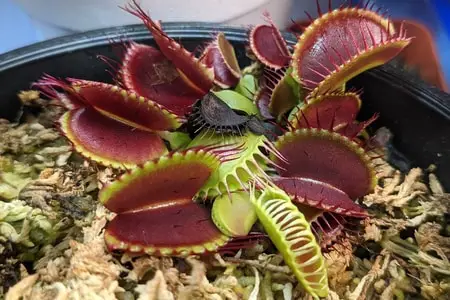Venus flytraps are native to South Carolina and North Carolina in the United States. They evolve to be carnivorous due to the challenging growing conditions in the area. They grow in soil lacking critical nutrients for most plants’ survival. Without those nutrients in the soil, venus fly traps had to evolve to extract such elements from somewhere else; that is where their trapping mechanism comes in.
In this article, I will share with you the life cycle of a Venus flytrap going through the years: from month one to 10+ years, and through the year’s growing seasons.
Venus fly traps can live for close to 20 years if they have enough access to sunlight, pure water, and cold winters for dormancy. Their life cycle stages are germination, growing season, flowering, propagation, and dormancy. Venus flytraps take 3-4 years to mature and start producing flowers, however they can propagate before maturity.
As Venus fly traps grow, they will reach maturity and also develop larger and taller traps. This chart shares the approximate size a Venus fly trap reaches over time, plus some key considerations for each year:
| Age | Trap Size | Recommended Pot Size (diameter) | Overview |
| Seedlings | Tiny | Any size | The seeds will sprout, develop working traps, and grow exponentially fast |
| 1-2 years | 1/8 inch | 2” | The plant will grow rapidly, they should experience their first dormancy, and grow multiple traps at a time |
| 3-4 years | 1/4-1/2 inch | 3″-5″ | The Venus fly trap will reach maturity and start producing flowers |
| 5-7 years | 1 – 2 inches | 6″ | The plant will reach its adult size, it will bloom multiple times every year in the spring |
| 7+ years | 1 – 2 inches | 6″ | The plant can continue to grow and divide for many years. In the right condition they can live up to 20 years. |
Now, let’s go over what to expect year over year:
Year 1: Germination and Seedlings
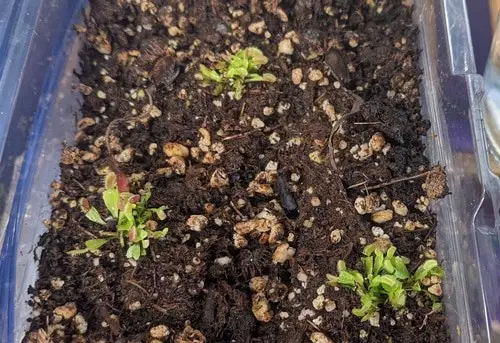
The first year of a Venus flytrap is very impressive. They germinate from these tiny black seeds that look like pods. Germinating Venus fly trap seeds is not extremely difficult, they need to be placed on top of carnivorous plant soil with plenty of water, humidity, and indirect lighting to germinate. You get the whole process here: Venus flytrap propagation guide.
Venus fly traps take 4-6 weeks to germinate depending on the seeds. Once, they sprout you will see some tiny green leaves. The seedlings will continue to need the humidity, water and lighting and they will start becoming stronger in the next couple of months.
Seedlings have the exact shape as adult Venus flytraps, but just very tiny. The growth accomplished in the first year is dependant on the environment. Plenty of sunlight ensure the plant will develop bright colors and grow in size significantly.
Do not worry about feeding your Venus fly trap the first year. Their traps work, so they might catch a gnat or other tiny insect, but feeding them is not necessary.
One of the most critical needs for Venus flytraps is dormancy. Venus fly traps must go dormant every winter to stay healthy. Without dormancy, venus fly traps can live for 1-2 years, but not longer than that. For that reason, I recommend learning about dormancy early on and ensuring your plants go dormant every winter.
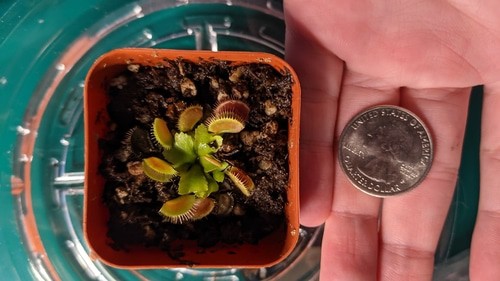
Year 2: Continuous Growth
Between year 1 and year 2 Venus flytrap undergo substantial growth. By the end of year two, they will develop traps that expand to 1/4 of an inch or even half and inch. Besides the trap side you will notice that the leaves in general become bigger, now the plant takes up a lot more vertical and horizontal space. At this point, the plant has most likely not reached maturity, so it won’t produce flowers. Still, the plant might be able to divide and produce clones of it self by rhizome divisions.
Make sure your Venus flytrap goes dormant every year to keep it healthy and also to ensure it continuous growing at a good rate. You can technically skip a dormancy period without killing your plant as long as you don’t skip multiple in a row. However, skipping dormancy, will delay your plants growth.
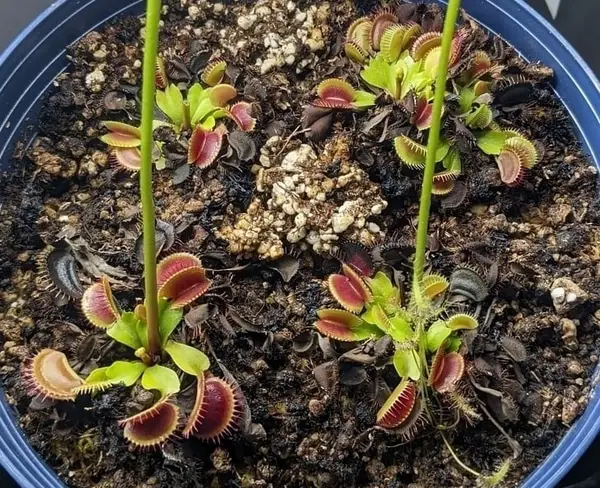
Year 3 -4: Maturity
At this point, venus flytrap have not reached their maximum size, but they will reach maturity.
Venus fly traps blossom when they reach maturity. They produce tubular stems that grow into flower blossoms for propagation through seeds. Then can produce multiple flower stems every yea, usually in the spring.
When a Venus fly trap flowers, it is a sign that is has reached maturity. There is no negative effect in plants, however, some people recommend removing the flower stalks before they flower to save the plant energy. Producing flowers won’t harm the plant, but will burn some energy that could be used for growing bigger leaves.
WHen Venus fly traps blooms, it is possible to pollinate the flowers and collect seeds for propagation. Each flower stalk usually carried multiple flowers that can produce dozens of seeds each.
You can learn more about the flowering process and what to do with this article.
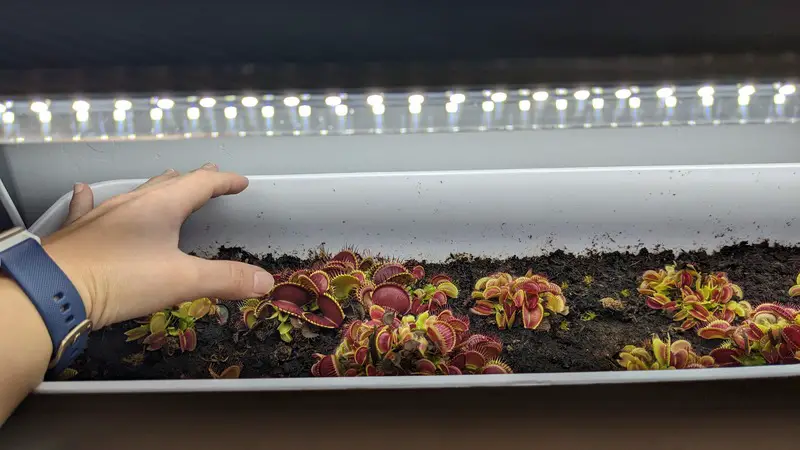
There is a unique way to propagate Venus flytraps through flower stalks (learn how it works!).
Year 5-7: Reaching Maximum Size and Continuous Propagation
After reaching maturity, Venus fly traps will continue to grow. Depending on the cultivar, Venus fly traps can develop traps as big oas 1.5 – 2 inches. Usually between year 5-7 is when they reach they maximum size,
The venus fly trap might continue to grow after that, but they growth will be marginal in terms of trap size. Still, they can continue growing in surface area.
At this growth stage Venus fly traps will produce multiple flowers every year and will propagate through divisions. When Venus fly traps are growing in a suitable environment they divide to produce clones of themself. Most plant grow a maximum of 6-8 traps per plant. Adult Venus flytrap can have dozens of traps, which means that they have divided, and now you have multiple clones of the parent plant growing together.
Venus Flytrap Life Cycle Stages Overview and Care
Germination: Venus flytraps produce seeds when their flowers are pollinated. The seeds from a Venus flytrap are tiny, shiny, and black. Also, their seeds do not need stratification. When growing Venus flytraps from seeds, attempt to germinate them as close to harvest as possible. When the seeds get older, the probability of producing seedlings lowers significantly. it is recommended that you sow seeds in the spring or early summer.
From sowing the seeds it can take up to 6 to 8 weeks to see any sprouts. fresh seeds tend to sprout the fastest.
Growing Season: Venus flytraps enter the growing season in the spring and finish it when they go dormant. During this season, Venus flytraps grow at full speed, increasing the traps’ size and sometimes dividing into multiple plants (vegetative propagation).
On average, 3-4 years is the amount of time it takes to grow Venus flytraps from seeds until maturity. Mature plants start producing flowers and can continue growing in size if given proper care.
Dormancy: In their natural habitat, Venus flytraps are exposed to cold temperatures (below 50 F) for several months in a row. During the winter months, Venus flytraps go dormant. The dormancy process is similar to hibernation. The plant goes into a resting mode for several months. During dormancy, Venus flytraps stop growing, they lose their leaves and kind of look down for several months.
Venus flytraps enter dormancy when they are exposed to temperatures below 45F for 2-4 weeks. Venus flytraps experience a full dormancy after 3 to 5 months in cold climates. The plants will exit dormancy as the temperature sizes, they will reflourish and start growing at a very fast pace.
Flowering: A few weeks after exiting dormancy, mature Venus flytraps will produce flower stalks in early spring. They might produce multiple stalks with dozens of flowers.
Since Venus flytraps spend a lot of energy producing flowers, many recommend stopping the flowering process by cutting the flower stalks before they develop. I personally do it sometimes, when I am not interested in the seeds.
Removing the flower stalks early on will save the Venus flytrap a lot of energy it can employ to grow and develop. However, if you leave the flower stalks, you can potentially pollinate the flowers and collect seeds.
Venus Fly trap Care Tips
Healthy Venus fly traps can live for many many years. This list of care tips will help you ensure your plant remains healthy:
- Light: Optimally they should receive 12 hours of sunlight, and the minimum is 6 hours of light. The light source might be natural light or artificial lighting (plant lights)
- Water: Venus flytraps must be watered with pure water only, such as rainwater, distilled water, and reverse osmosis water. Tap water and bottled water kill carnivorous plants. The soil of the plant must always remain moist. Always keep the ground humid, but do not flood. Venus flytraps do not grow in swamps.
- Soil: Employ nutrient-free soil for carnivorous plants. Never employ enriched soil, full of fertilizers. This article covers many soil options for Venus flytraps.
- Feeding: Venus flytraps do not need to capture insects to survive, but they benefit from them greatly. Place Venus flytraps outdoors, and they will have plenty of access to food. Also, consider feeding your plant to provide extra nutrients.
- Fertilizers: Do not fertilize Venus flytraps. The chemicals in the fertilizers can hurt the plant
- Flowers: After reaching maturity, Venus flytraps start producing flowers every spring. Skipping it allows for further growth and development.
- Dormancy: Venus flytraps must undergo a dormancy period for 2-3 months during the winter. Venus flytraps must go dormant every winter to remain healthy and live for many years. Ensure your plant will experience this resting period by placing them in a cold location. For example, outdoors, in a cold garage, or porch.
Are you thinking about growing your Venus flytraps indoors? This guide: Venus Flytrap Indoor Care explains the requirements for lighting, watering, dormancy, and much more…


